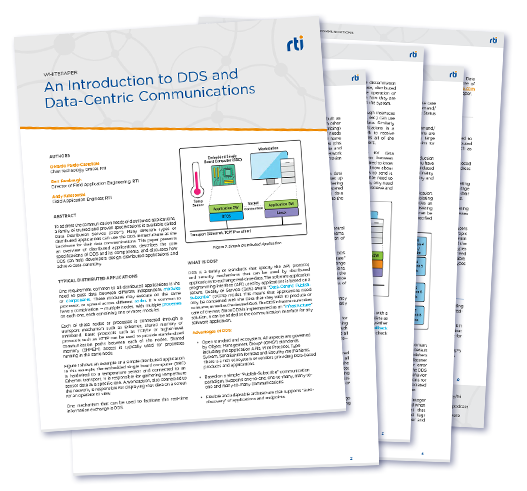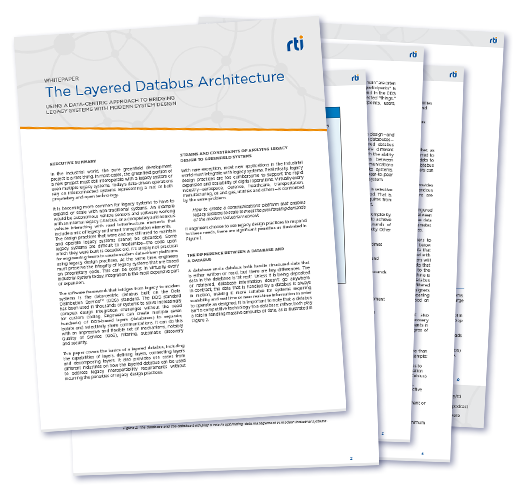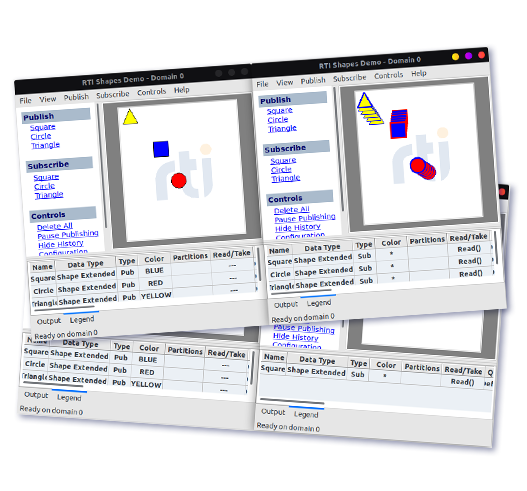Fast device-to-device integration
Delivery times in milliseconds or microseconds
RTI is the world’s largest DDS supplier and Connext is the most trusted software framework for critical systems.
|
From downloads to Hello World, we've got you covered. Find all of the tutorials, documentation, peer conversations and inspiration you need to get started using Connext today.
RTI provides a broad range of technical and high-level resources designed to assist in understanding industry applications, the RTI Connext product line and its underlying data-centric technology.
The monthly RTI Newsletter lets you in on what’s happening across all the industries that matter to RTI customers.
RTI is the infrastructure software company for smart-world systems. The company’s RTI Connext product is the world's leading software framework for intelligent distributed systems.
A data-centric software framework for distributing and managing real-time data in intelligent distributed systems.

Typical distributed systems require data to be shared across multiple devices and multiple networks, from the edge to the cloud. This is challenging because the sheer volume and variety of data — not to mention the stringent safety and security requirements — can easily overwhelm a network. These challenges require new ways to manage increased data volume, data variety, performance requirements, safety risk and security certifications. One of the most important innovations is the databus and its unique ability to manage data flow.
A databus is a data-centric software framework for distributing and managing real-time data in intelligent distributed systems. It allows applications and devices to work together as one, cohesive system.
In intelligent distributed systems, managing dataflow is critically important. The databus — designed specifically to manage dataflow in intelligent distributed systems — simplifies application and integration logic with a powerful data-centric paradigm. Instead of exchanging messages, software components communicate via shared data objects. Applications directly read and write the value of these objects, which are cached in each participant.
Click image to enlarge
The databus provides for data in motion where a database provides for data at rest.
A database implements data-centric storage. It saves old information that you can later search by relating properties of the stored data.
A databus implements data-centric interaction. It manages future information by letting you filter by properties of the incoming data. Data centricity can be defined by these properties:
It is important to note that a databus is not just a database that you interact with via a pub-sub interface. There is no database. A database implies storage: the data physically resides somewhere. A databus implements a purely virtual concept called a "global data space" and implies data in motion.
Click image to enlarge
Both database and databus technologies replace the application-application interaction with application-data-application interaction. This change is absolutely critical. It decouples applications and greatly eases scaling, interoperability and system integration which is crucial for intelligent distributed systems. The difference is really one of old data stored in a (likely centralized) database versus future data sent directly to the applications from a distributed databus.
When building an intelligent distributed system, try the Connectivity Standard Selection Tool to help decide which connectivity standard is the best fit for the use case.

An introduction to the trusted specification proven to address communication needs of distributed applications.

Learn about using a data-centric approach to bridging legacy systems with modern system design.

Learn about using a data-centric approach to bridging legacy systems with modern system design.
The DDS standard has been used in thousands of systems to solve increasingly complex design integration challenges without the need for custom coding. In intelligent distributed systems, a common architecture pattern emerges that is made up of multiple databuses layered by communication QoS and data model needs. Engineers can create multiple (even hundreds) of DDS-based layers (databuses) to separate, isolate and selectively share communications.
A layered databus architecture is the ideal framework for resolving cross-network data sharing challenges and developing multi-tiered distributed systems of systems.
Delivery times in milliseconds or microseconds
With and between databuses
Comprising hundreds of thousands of machines, sensors and actuators
Allowing extreme availability and resilience
Enabling development of complex systems design
RTI Connext, built on the DDS standard, features a databus that eliminates network bottlenecks by allowing applications to exchange data via a publish-subscribe, trusted peer-to-peer communication method. Connext handles the details of data distribution, synchronization and management, including serialization and lifecycle management. Its reliability, security, performance and scalability are proven in the most demanding industrial systems.